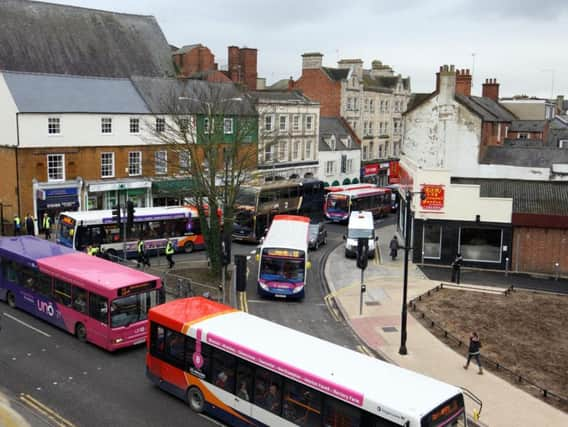Figures show Northampton's £7 million bus station has caused a 'public health emergency' claims Green Party


In September it was revealed nitrogen dioxide levels had exceeded the legal threshold around Sheep Street by around 25 per cent.
But the Northamptonshire Green Party believes that spike in pollution was not just a one-off.
Advertisement
Hide AdAdvertisement
Hide AdFigures obtained via the Freedom of information Act show the borough council's own pollution monitors have registered illegal limits 80 per cent of the time since the bus station was opened.
The authority says the readings do not accurately portray an increase in exposure, or an increased detriment to health.
But the Green Party has reiterated its calls to fast-track a new air quality management area around the bus station - saying the figures represent a "public health emergency."
Northamptonshire Green Party spokesman, Steve Miller, said: "We requested the council’s figures for air quality around North Gate, and they show that, since the opening of the bus station up to the end of 2015, the levels were exceeded 80 per cent of the time.
Advertisement
Hide AdAdvertisement
Hide Ad"The yearly averages for 2014 and for 2015 are both above the legal limits.
"The figures for 2013 show that this issue is directly related to the opening of the new bus station."
The legal limit for nitrogen dioxide is 40 microgrammes per cubic metre. In 2013 the average levels were between 32 and 37 microgrammes.
But there is a marked rise in the figures after the bus station was built in March 2014.
Advertisement
Hide AdAdvertisement
Hide AdThe nitrogen levels rose to between 42 and 50 microgrammes in 2014, and between 41 and 53 in 2015.
Mr Miller, said: "This air quality problem has been caused by the council."
When the Northamptonshire Green Party called on the air quality management area to be put in place around the bus station in September, the council said it had no intention to do so, as its Low Emission Strategy currently being worked plans to tackle air pollution across the entire town.
But since then, a lost legal case has forced the Government to admit its plans for tackling air pollution were based on over-optimistic estimates.
Advertisement
Hide AdAdvertisement
Hide AdMeanwhile, in Northampton 6.1 per cent of fatalities every year are believed to be premature deaths caused by air pollution.
Mr Miller addressed the council by saying: "Take this opportunity to accept that the air quality issue at North Gate is affecting the health of people in Northampton every day and fast track this as a new air quality management area.
"This is a public health emergency and the people living and working in Northampton need you to take it seriously, starting from now."
The borough council says air quality monitoring has two purposes.
Advertisement
Hide AdAdvertisement
Hide AdA spokesman, said that one is to inform the council of air quality where there is established housing, and the other to outline levels where housing does not exist but might be applied for in the future.
In addition the authority says it is not always practical to undertake monitoring close to where the public would experience relevant “exposure.”
A spokesman added: “Some of the monitoring does show higher readings but not in locations where there is residential housing. The council recognises that air quality levels are above the intervention limit in the area, but it is not wholly the case that pollution experienced by residents is as high as the monitoring suggests.”
Councillor Mike Hallam, Northampton Borough Council cabinet member for environment, said: “We are working towards a borough-wide low-emission strategy as this is the best means of ensuring that areas in need of attention receive it, and the whole borough benefits as a result.
“We recognise that the bus station is one of the causes of emissions, and we are working with all concerned to ensure that we tackle this in the most comprehensive way.”